In 2008, I re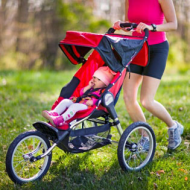 leased a piece of small piece of research that caused an international storm. It tried to make a simple point: that the design of strollers shapes our children’s emotional and brain development. The study was, at the time, the only piece of empirical research that I could find that had even tried to explore that possibility.
leased a piece of small piece of research that caused an international storm. It tried to make a simple point: that the design of strollers shapes our children’s emotional and brain development. The study was, at the time, the only piece of empirical research that I could find that had even tried to explore that possibility.
I thought that parents and manufacturers deserved to know that strollers were important. So did the National Literacy Trust, who commissioned the research, and the Sutton Trust, who funded it.
That shows the far-ranging interest in this issue. The National Literacy Trust is an organization interested in reading, and the Sutton Trust is an educational charity. Yet both of them were interested in baby buggies. They had teachers behind them, urging them to give serious consideration to the idea that strollers could be influencing language development. Primary teachers have been witnessing a steady decrease in children’s linguistic abilities upon starting school, and they had wondered if the fact that so many strollers are now designed to face outward, rather than toward the adult, might be one of a variety of possible factors contributing to that decrease.
So the aim of our 2008 study was simple: to be able to confirm whether or not the direction that a stroller faces has a significant impact on how adults interact with their baby. The take home message of the study was that it does. We found that simply turning the buggy around doubles the amount of conversation that babies experience. The most surprising thing we discovered, once we looked closely at what was happening for children on High Streets in Britain, was just how infrequently babies seemed to be taking part in conversations with parents. Of the nearly 3000 observations that volunteers made of parent-child pairs, talking was observed in only 22% of those observations. Talking was twice as likely to be happening when children were being carried or walking (more than 40%) than when they were in strollers (less than 20%).
The media’s coverage of that story – including an invited Op-Ed piece in the New York Times – made it a bumpy and confusing ride for parents across the globe. The international storm extended from France to India to Australia and beyond. Responses from parents and professionals alike ranged from “I am so relieved to see that a scientist is finally talking about this” to “Utter hogwash”.
Well, guess what? A new study carried out in New Zealand has just replicated those earlier findings. It was carried out by Dr. Ken Blaiklock at the Unitec Institute of Technology in New Zealand, recently published in the New Zealand Research in Early Childhood Education Journal.
Blaiklock’s study showed the same three key patterns as the 2008 UK study. First, the amount of conversation observed to be occurring within parent-child pairs, out walking in public spaces, was very low. Blaiklock’s observations showed that they were even lower in New Zealand (5%) than in the UK (22%). Second, conversations were more likely to be going on when strollers faced toward the pusher (8%) than when the stroller faced away (.5%). Finally, outward-facing strollers are by far the most common model, even for infants estimated to be below the age of 1 year (68% vs. 12% of observations where a stroller was being used as transport, the remainder of his observations comprised of supermarket trolleys (3%) and infants being carried (17%)). Blaiklock concluded: “It is possible that parents may not always be aware of the value of making use of the one-to-one interaction opportunities that occur when accompanying children in prams.”
How do we help the public to think about this issue in more depth? How do we do that without causing parents to be alarmed or to feel guilty? That’s what happened in 2008. The media’s coverage of the story led parents to feel worried and defensive. The language used didn’t help parents to feel curious or informed. The coverage made it seem like a rather silly, over-stated issue.
I continue to think, though, that parents do want to know about this information. I remember in particular one of the mothers who took part in that 2008 study. Like all the participating parents, we had invited her to take her baby out for a walk in a stroller that we’d provided, which faced either outward or inward. Half way along, myself or one of my students met the parents and helped them switch to a stroller that faced the other direction. This mum came back from that walk saying, “I had no idea how much of a difference the direction of a stroller would make. We had such a good time when she faced me. I am off right now to buy a new stroller.” And she did! I wanted to send a request to Mothercare for a commission on the sale they had just made because of my research study.
I think also about the difference that this information makes for children in nursery. VIP Childcare, based in Elgin, makes a point of taking the children they care for outside every day. They decided to replace their outward-facing double-buggies with inward-facing ones, even though this was at some cost. Very creatively, they carried out a systematic observation of the children’s experience in the buggies they were using before and after. They were able to show a definite change in the children’s behaviour and experience. Even the staff reported higher levels of enjoyment when out on a walk.
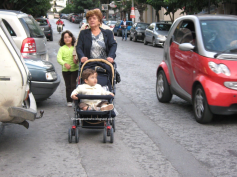 Why should strollers matter so much? The stroller years are precisely those when human brains are developing more rapidly than they ever will again. Young brains are being shaped by every single tiny experience that a child has. If outward-facing buggies significantly decrease the amount of chat that a baby gets to have, that will inevitably be impacting on language development. If the world that the baby is looking out to is alarming, because it is full of loud traffic, shopping bags, and random adults’ knees, then the baby might end up a bit anxious. It’s understandably easy for busy parents to overlook that anxiety or the opportunity for chatter when they are feeling hassled, trying to negotiate all that traffic, and they can’t hear the baby or see his/her facial expressions.
Why should strollers matter so much? The stroller years are precisely those when human brains are developing more rapidly than they ever will again. Young brains are being shaped by every single tiny experience that a child has. If outward-facing buggies significantly decrease the amount of chat that a baby gets to have, that will inevitably be impacting on language development. If the world that the baby is looking out to is alarming, because it is full of loud traffic, shopping bags, and random adults’ knees, then the baby might end up a bit anxious. It’s understandably easy for busy parents to overlook that anxiety or the opportunity for chatter when they are feeling hassled, trying to negotiate all that traffic, and they can’t hear the baby or see his/her facial expressions.
Most adults have no idea just how tuned in babies’ brains are to the environment around them. That’s why I show all those video clips of young babies in my talks. I’m trying to help us to think about how human brains work, how connected babies are from birth, how emotionally dependent they are on the people around them. Babies need us grown-ups to pay attention to their emotional needs. Babies have immature brains that mean they can’t yet manage those emotions themselves. They depend on our help to learn how to do that.
So: every minute of a baby’s experience is having an impact on their brain development. This includes the time that we adults think of as ‘in between’ time. While we may think of the time in the buggy as ‘just nipping into the shops before we get home’, the baby doesn’t know that. The time in the buggy is as ‘real’ for him or her as any other time.
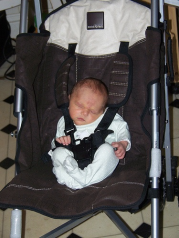 That doesn’t mean that parents have to pay attention to babies every second of the day. That’s a relief for parents. And it also confirms what parents know instinctively. Babies don’t need constant attention. It does mean, though, that they need enough attention. And they need it at crucial times. Babies especially need attention and comforting when they are feeling uncomfortable and at risk of being overwhelmed. It is in these moments that they most need reassurance, which comes through the responsiveness of someone they trust. It is through relationships that babies learn how to deal with their discomfort and anxiety. Having a buggy that faces away, especially probably during the first year, makes it more difficult to let your mum or dad know that you are needing them. The more time that babies have to spend in anxiety, the more their brain comes to expect anxiety, and thus goes on to actually create it.
That doesn’t mean that parents have to pay attention to babies every second of the day. That’s a relief for parents. And it also confirms what parents know instinctively. Babies don’t need constant attention. It does mean, though, that they need enough attention. And they need it at crucial times. Babies especially need attention and comforting when they are feeling uncomfortable and at risk of being overwhelmed. It is in these moments that they most need reassurance, which comes through the responsiveness of someone they trust. It is through relationships that babies learn how to deal with their discomfort and anxiety. Having a buggy that faces away, especially probably during the first year, makes it more difficult to let your mum or dad know that you are needing them. The more time that babies have to spend in anxiety, the more their brain comes to expect anxiety, and thus goes on to actually create it.
Once we get this far in the discussion, it becomes easy to realise that the logic applies to other forms of baby transport, especially slings (baby carriers) and car seats. Slings keep a baby close to a parent’s body, and thus in constant reassurance. This is why many parents choose to use them. Giving slings away to families living in ‘vulnerable circumstances’ would probably make a great health intervention.
Car seats, on the other hand, bring up many of the same challenges as strollers. The laws in many Western countries require that infant car seats be rear-facing in order to protect infants in the case of accident. While this protects their physical health, it may interfere with their emotional health, because it prevents the baby from seeking and making easy contact with the driver. That’s part of why a parent can easily end up in a fight getting the baby to settle into a car seat.
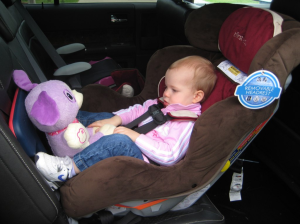 Yet, the idea that car seats should be impacting on the development of infants’ brains and emotional health hasn’t been considered in the scientific literature or by professionals. That is one of the reasons that Jane Leavey has just founded the new UK-based organization BabyBWell. She is keen to help parents to understand more about the issues associated with car seat use. She advocates a 90 Minute Max Rule: never travel longer than 90 minutes without giving the baby a chance to get out of the car seat and move around, even if its ‘just’ in your arms. Indeed for a young baby, there’s no ‘just’ to it. There’s nowhere they would rather be than in a parent’s arms. I’ll be exploring the issue further in my next blog post.
Yet, the idea that car seats should be impacting on the development of infants’ brains and emotional health hasn’t been considered in the scientific literature or by professionals. That is one of the reasons that Jane Leavey has just founded the new UK-based organization BabyBWell. She is keen to help parents to understand more about the issues associated with car seat use. She advocates a 90 Minute Max Rule: never travel longer than 90 minutes without giving the baby a chance to get out of the car seat and move around, even if its ‘just’ in your arms. Indeed for a young baby, there’s no ‘just’ to it. There’s nowhere they would rather be than in a parent’s arms. I’ll be exploring the issue further in my next blog post.
And as I end this blog, I want to stress: this is not just an issue for parents. It is an issue for professionals, manufacturers, and retailers alike. There is virtually no discussion amongst any of these communities about the psychological importance of strollers and car seats. Blaiklock made that observation in his recent paper:
“The website (www.plunket.org) of Plunket (the largest provider of health and development services for children under five) provides much information on parenting and child development but makes no mention of the significance of orientation of prams…. The national consumer organisation in New Zealand recently published a review of children’s prams (Fredrikson, 2011). Again, no mention was made of the value of parent-facing prams for promoting interaction….The websites and stores of major retailers of children’s prams in New Zealand do not appear to provide information on the significance of using adult-facing prams.”
It is likely the members of these professional communities simply do not know, since even the scientists have not thought to gather data. When I was undertaking the preparations for my 2008 study, a colleague said to me, “Suzanne, you’re not really considering doing research on baby buggies are you? Do you not think you may put your reputation as a serious scientist at risk?” My shoulders hardened with my resolve.
A few manufacturers have begun to consider these issues. Graco hosted an event in 2011 that launched their new parent-facing model. The company Stokke has probably done the most of any company to think through their responsibility as designers. They have entitled their entire line of buggies ‘Connection Strollers’, and have made films that try to explain the importance of connection to consumers (see below). Some retailers have also tried to communicate the significance of connection to customers.
My view is that these commercial industries have a moral responsibility to learn about child development. The products they design, the items they sell, the advice they give have an impact on the brain development of our children. Parents and society at large are right to expect them to fulfill that duty.
They can perhaps be forgiven for not fulfilling that responsibility until now. Most probably did not know. But they can be expected to now, with your help.
Once you finish reading this blog, take one simple step. Tell someone who needs to know.
- Forward this blog to another parent or health visitor.
- Find out if your local pram supplier or the manufacturer of your stroller knows about this stuff.
- Drop an email to Dr. Ken Blaiklock (KBlaiklock@unitec.ac.nz) to thank him for being the only other scientist in the world to carry out an empirical study on strollers.
- Send a thank you to the editor of the New Zealand Research in Early Childhood Education Journal thanking her for making this research report an open access publication (Sarah@childforum.com). Not all scientific journals would have been willing to take this step.
- Call a local journalist and get them to do a story on this issue.
- Ask the nursery or childminder who cares for your child if they know about the report produced by VIP Childcare.
- Support Jane Leavey’s campaign at BabyBWell (www.babybwell.co.uk).
- Send a tweet to the Sutton Trust (@suttontrust) or the National Literacy Trust (@Literacy_Trust) to let them know that you are still reading the report that they funded in 2008, given that it was considered by some commentators at the time an ‘outrageous waste’ of money.
- See if there are any other funding agencies out there willing to be as courageously wasteful as the Sutton Trust :-).
Next: Emotional Safety Standards for Strollers and Car Seats?
Find us on Facebook: http://www.facebook.com/drsuzannezeedyk
Find us on Twitter: http://www.twitter.com/suzannezeedyk


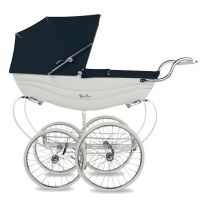


There have been studies about child development in African countries when mothers carry their babies everywhere on their backs. Babies up to 6 months in those places have greater intellectual development than North-American babies, presumably because of the close connection to the mother and the fact that they go everywhere with her and are more stimulated. After 6 months, the trend reverses, possibly because the effects of malnutrition begin to set in and other issues in those countries.
LikeLike
Carrying the child on the back is a definite way of connecting. I often wish this point were made, when we see appeals due to poverty. Prof Heidi Keller, based in Germany, has done some great work on cross-cultural differences in relationships. She has a new book due out soon: Different Faces of Attachment, with Cambridge University Press: http://www.cambridge.org/gb/academic/subjects/psychology/developmental-psychology/different-faces-attachment-cultural-variations-universal-human-need
LikeLike
Actually, there are affordable brands like Goodbaby that has reversible handle bars. It’s flexible. Parents can simple click a button & push the handle forward (so pram is being pushed backwards while facing baby). It allows parents the choice. Someday when baby grows into a toddler, he or she might occasionally prefer to soak in the environment & enjoy the view of surroundings instead of facing parents.
LikeLike
There are indeed a growing number of brands who make it easy to switch the way the baby faces. Not all are affordable, so its really helpful to hear about Goodbaby. The fact that some brands have a design that makes this so possible leads one to wonder why all brands don’t have a design like this. It is certainly the case that when children get older, they are likely to want to alternate orientations.
LikeLike
Yeah, this thing is better! Put them in a sling til they can toddle around then shove them in a wagon so that they can interact with things 360 degrees. 🙂
http://www.amazon.com/Childrens-Folding-portable-standard-EasyGoWagon/dp/B0054RNYOI/ref=sr_1_12?ie=UTF8&qid=1400187992&sr=8-12&keywords=collapsible+wagon
LikeLike
Surely the amount of TIME spent in a buggy, and what the parent and child are doing together the rest of the time is relevant too?
Re the car seats, yes for safety reasons they need to face backwards when the baby is from birth to ??I cannot remember the age. They should also NOT be used in the front seat of the car if the car has airbags. Therefore the baby is in the backseat and facing backwards. (I well remember travelling with one parent in the back seat with the baby while the other drove the car.) In the situation where there is just the baby and the driver, face contact is impossible. Surely therefore the amount of time spent in this situation is really important, and long trips in this position should be avoided where possible. This can be difficult: here for me in NZ it has always been at least a two hour drive from home to visit any family member. The situation may be different in the UK with much better public transport.
Delighted to see this research came from New Zealand!
LikeLike
Absolutely. The overall question to ask is: what is the baby’s whole experience? The direction a transport device faces, how comfortable it is, how long they spend in it, how easy it is connect with a familiar adult, how tuned in the adult is able to be, how loud the environment is.
Synapses in the brain are being created every minute of babies’ experiences. If parents are aware of how much brains are shaped by experience, they can make more informed decisions about the kinds of experiences they want babies to have of transport — and of everything else in a baby’s day as well. The campaign BabyBWell advises a 90 Minute Max Rule in the car seat — which speaks to the challenges faced in regions where long drives are a necessity. http://babybwell.co.uk/infant-car-seat-safety/
LikeLike
I agree with the majority of the points in this article and have a face to face stroller myself. I do think it’s dangerous to imply that parents should forward face their child in a car though. Children are 5 times safer rear facing! Not just infants. I plan to rear face my daughter for as long as possible. Until she’s around 4 years old. Mirrors placed strategically can mean the driver can easily check the child is ok and happy. I fact my daughter and I sing and chat on the car very happily.
LikeLike
In total agreement that the point for parents is to be able to think through both physical and emotional safety. I followed up some of the points that there wasn’t space to cover in the first blog in a second blog a week later. It addresses more on the car seat issue. https://suzannezeedyk.wordpress.com/2014/04/14/emotional-safety-standards-for-strollers-and-car-seats/
LikeLike
Pingback: Are strollers facing the wrong way? | Staying Afloat Mom
We have a Quinny Zapp stroller that can face inward or outward. I also have slings and an Ergo, but my back can’t handle the demands for more than about 15 minutes, so I turn to our stroller a lot. New babies don’t want to see the sights and the sounds of the world — they want to see their parents’ faces to give them comfort and calm. We didn’t even turn our baby’s stroller seat around until he was about 5 months old, and we still switch from out to in-facing (he is 13 months old now).
LikeLike
have someone check the fit for your slings and how your toddler is positioned. If your back is hurting, you probably do not have them adjusted correctly. they should actually help back strain by the way they distribute the weight across the back and keep baby close to you. If they are loose, saggy where baby is or bunched at shoulder or on back, you will have more strain. It takes a while to fine tune baby wearing. I have had trouble with back problems after my 4th child from poor fitting carriers and car seats and then have worn my last baby, #5, a lot from birth… til about 4 yrs old! It actually helped my back and posture.
I agree with everyone on here that babies like interaction with their family rather than passively in stroller looking at the world go by.
LikeLike
So if you do need to use a forward-facing stroller, what can you do to improve the linguistic challenges mentioned? I am a parent who talks to her child a lot when we’re out driving in the car, or using the stroller. It’s not the same as face to face talking, I know, but does it help with the language development and keeping more of a connection (albeit not physical) with mom and dad?
Does using a mirror with a rear-facing car seat help a little bit? And is there an amount of time in the forward-facing stroller/rear facing car seat that should be looked at when it comes to this problem? I did see the 90 minute limit for in the car.
LikeLike
You’ve already got the key: talk, talk, talk. The central point is not the direction that the stroller faces. Its the baby’s need for connection. So if you’ve got a forward-facing stroller, then keep that need for connection in mind, and be sure you are doing lots of talking. Maybe pause often to go round and see the baby, and speak to her face to face. Be sure she can hear you when you chat. If she gets fractious, definitely see what the matter is. Don’t let the design of the buggy keep you from connecting in ways that you would want to. It sounds obvious to say, but its surprising how easy it is to let design of objects shape behaviour in ways we never thought about. I was surprised when, in the original study, the a forward-facing buggy decreased language between parents and children by 50%.
LikeLiked by 1 person
Thanks. I’m glad to hear that my talking is benefitting my daughter’s connection with me, and hopefully her language development. It’s fun to chat with her, telling her what we’re driving by or asking her what she’s seeing when we’re walking while she’s in the stroller. Even my husband is starting to do that. 🙂
LikeLike
what about the fact of putting a pacifier every time the baby tries to say something! Maybe they should do an study of how pacifiers influence also in their talking abilities. But maybe people that put pacifiers on babies and people who put them on the stroller looking the other direction, are actually the same people… so it’s a difficult study to do.
LikeLike
Yep, pacifiers are another thing that speech and language therapists often speak about. The fact that babies use their mouths to learn about the world, to provide reassurance to themselves when they feel anxious, to eat, to talk, and a whole lot else shows how there is an overlap in lots of decisions for parents to make. The important thing for brain development is baby’s overall experience, not any one issue in particular.
LikeLike
Pingback: ¿Cómo moldea la carriola el crebro de mi bebé? | Ayurveda